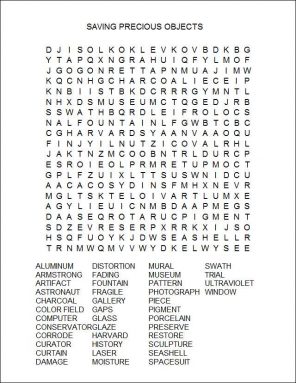Cool Jobs: Saving precious objects
Museum conservators preserve and restore art works and other special objects — from sculptures to spacesuits
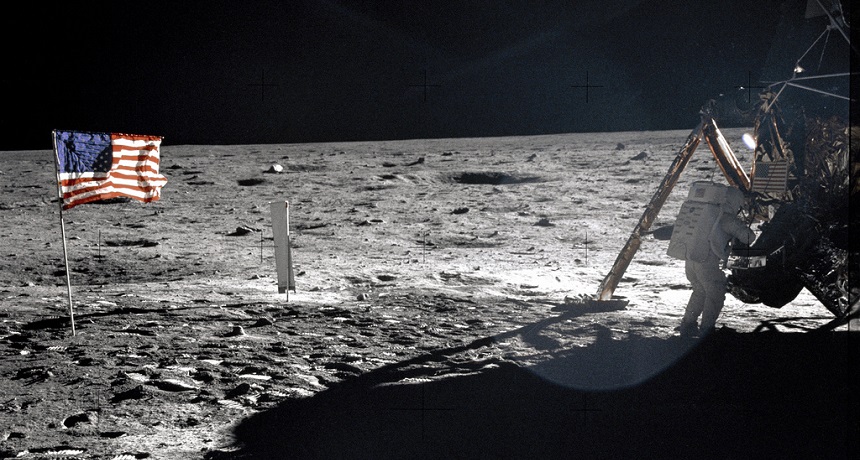
Neil Armstrong (right) seen wearing his pressure suit on the lunar surface July 20, 1969. That moon suit, now a prized artifact in the Smithsonian Institution’s collection of space wear, is deteriorating. Museum scientists are working hard to limit further damage.
NASA
Astronaut Neil Armstrong will always be famous as the first human to walk on the moon. But Armstrong said his mission succeeded because of thousands of people on the ground. Mechanics, inspectors and others who worked on the Apollo 11 flight all had the same attitude, he said: “If anything goes wrong here, it’s not going to be my fault, because my part is going to be better than I have to make it.”
Lisa Young is now charged with the care of one key part of that mission. Young works at the Smithsonian National Air and Space Museum in Washington, D.C. As a conservator of museum artifacts, her job is to conserve, or protect, prized items so that they will last as long as possible. She works with curators — experts who choose objects for the museum’s collections and who decide how to display them. But Young’s job is more specialized. Objects change as they age. She must learn what it takes to preserve them.
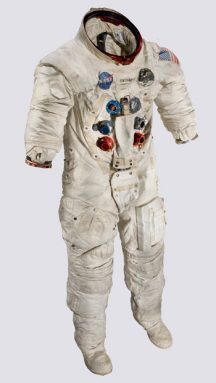
“Each suit is made of more than 24 materials,” Young explains. They include metal, synthetic fabrics, rubber and plastics. “They are attached to one another in layers,” she notes. And one material can interact with its neighbor. “We can’t separate them because that would mean taking the suits apart.” Adding to the problem, curators can’t see what is happening inside of those layers.
Objects age, just as people do. Drawings and photos fade. Metals turn dull or rusty. Cloth can dry out and become brittle. Spacesuits start to come apart. Conservators like Young are experts at protecting and restoring precious objects. Along with art or history, many also have studied chemistry, physics, archaeology or other scientific fields. They work behind the scenes, often using advanced tools such as laser scanners and computer modeling.
Here we learn how three conservators are saving rare and valued objects. Young wanted to figure out what happens as high-tech materials age so that she could learn how to better preserve spacesuits. One museum wanted to use conservation technologies to sculpt new missing pieces for a valued — but broken — sculpture from the 1740s. And another museum wanted to learn how it could display a set of huge modern paintings so that they wouldn’t look as badly faded as they had become.
In each case, conservators found unique ways to study the damage so that they can slow it. Even better, they might be able to restore those works so museum goers can appreciate the art or artifacts for generations — if not centuries — to come.
Home from space
Until the Space Shuttle program began in 1981, spacesuits were designed to be used once and then discarded. No one worried about whether the materials would last. But now signs of the suits’ aging are obvious. Light has faded the outer fabrics, Young notes. Fibers are becoming brittle and threaten to break. Plastics have lost some of the plasticizers — chemicals that once made them flexible. Aluminum parts have been corroding. “If you don’t handle the suits correctly,” she says, “you can certainly damage them.”
To minimize exposure to light and moisture, the museum staff rotates which suits are on display. To limit damage, staff members put the suits onto trays before moving them into or out of storage. Even small amounts of moisture in the air can corrode metals, so the suits are always kept in low-humidity display cases. Conservators put packets of silica gel and charcoal into the cases, too. These absorb moisture and any gases produced by materials that may be breaking down.
The suit Armstrong wore to the moon is the prize of the collection. The museum would like to put it back on display to celebrate the 50th anniversary of the moon landing in 2019. “To do that we need to build a mannequin inside the suit to support it,” explains Young. But that can’t be done until her team has assessed what parts of the suit have given out over time. And “we would never consider taking Neil Armstrong’s suit apart,” she notes. Any change to it, she explains, could risk erasing some of “the history associated with his mission.”
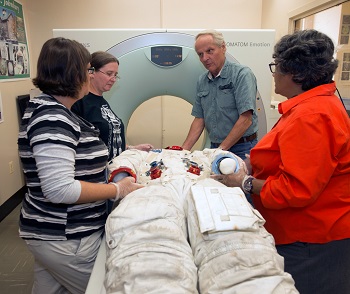
A machine beams X-rays at some target from many different angles. A computer then assembles the resulting X-ray images to produce a view of what’s inside the scanned object. The conservators are still analyzing data from the scan. But it should show what is happening between the suit’s many layers. With such data in hand, Young’s staff will be able to design a mannequin to support the suit without causing any more damage.
In college, Young studied history and archaeology. Back then, she expected to work with old objects, not modern objects, such as spacesuits. She earned a graduate degree in conservation science, which included two years of chemistry. Then she worked on digs at U.S. Civil War sites and learned how rubber and other 19th-century materials aged. Now she works with conservators who handle aluminum and other space-age materials.
“These suits are fragile,” Young notes. “But they worked well. And we’re still learning from them.”
A porcelain puzzle
Slowing the time-related breakdown of aging artifacts is just one of the challenges that museum conservators face. Sometimes they have to repair valued items that have sustained damage over the years. That includes a huge fountain at the Victoria & Albert Museum in London. It depicts the god Neptune with his bride being pulled on a chariot made of seashells. The sculpture is made of porcelain, a famous kind of hard white china. But when the museum acquired it in 1870, it consisted of a mound of broken pieces — more than 150 in all.
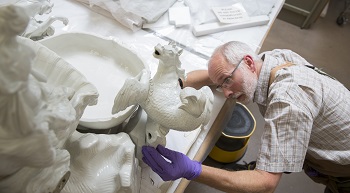
“We had cupboards full of broken parts,” says Reino Liefkes. As a curator at this museum, he helped design exhibits and manage artifacts. In this case, some of the fountain’s pieces were missing, he notes, “and we had extras of others.”
Two years ago, Liefkes launched a project to finally put this porcelain puzzle back together.
He started by visiting the company in Meissen, Germany, that had produced it. Its factory is still producing fine porcelain. Liefkes also found a garden fountain in the nearby city of Dresden that had been the model for the Meissen sculpture. He even tracked down a reproduction of the porcelain fountain that had been made in the 1800s.
A photographer made three-dimensional (3-D) images of that 19th-century fountain. He started by scanning it with a laser. That laser projected a pattern onto the fountain’s surface. The object’s complex shapes created distortions in the pattern. With a camera, the photographer recorded these shape-linked patterns from several angles.
Later, a computer linked all of the images taken into a full 3-D representation of the fountain. The computer also filled in any gaps for areas that were not quite clear on the scans.
Conservators then compared this to the pieces of the fountain they had in storage. This showed them what pieces they were missing. By feeding descriptions of them into a 3-D printer, they could now build replacement pieces out of resin. This was the first time this museum had used 3-D printing to reconstruct a damaged object.
To make new porcelain parts, technicians made molds from the 3-D printed pieces, and the porcelain clay was pressed into these molds. Yet even knowing what shape they should be, making the new parts proved challenging. For instance, porcelain clay shrinks about 18 percent when it is fired. So Liefkes’ team had to enlarge the 3-D scans so the pieces they created would shrink to the correct size.
“To get them exactly the right size,” says Liefkes, “there were endless trials of different glazes and porcelain types.”
The treasure again measures 4 meters (13 feet) long — about equal to four baseball bats laid end to end — and 1 meter high. Made in 1748, it came from a time when wealthy nobles liked to impress guests at their fancy dinner parties. After the main course, diners would leave the room while servants cleared away the dishes. When the guests returned for dessert, the tables were set with fancy sculptures called table fountains. Water scented with rose petals ran through it, flowing over the figures and down into a basin. Such art works showed off the host’s wealth and good taste.
The Neptune fountain was a prime example of this type of art.
“It’s magical to see it reconstructed with modern tools,” Liefkes says. The fountain will go on display in the fall of 2015 at the museum. “Meissen was the most famous factory of its time,” he notes. The restored fountain now will be a highlight of the museum’s collection.
(Story continues beneath slideshow)
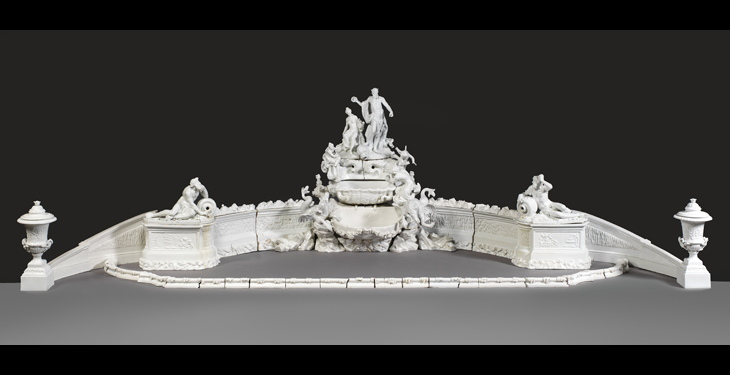
Liefkes is from the Netherlands. There he studied art history at Leyden University. He joined the Victoria and Albert Museum in 1992, and eight years later became head of its Ceramics and Glass Section.
What always fascinates him, he says, is the fact that these materials come from very basic raw ingredients — clay (for ceramics) and sand (for glass). But using heat, artistry and technology, people can “shape them into something beautiful and useful,” he notes.
In the red
At the Harvard Art Museums in Cambridge, Mass., there is one room that holds just five paintings. Each is huge. Known as murals, they stretch from ceiling to floor, covering large swaths of wall. They were painted by Mark Rothko. These “color field” paintings show large shapes floating against colored backgrounds. The Russian-born Rothko wanted viewers to see his works close up so that they would feel surrounded by color. Some of his color-field paintings have sold for more than $70 million.
The Harvard University murals, painted in shades of deep red and plum, were designed to be hung in a dining room at the top of a tall building there. The room had large windows. Rothko knew sunlight would fade a paint’s colorful pigments. The sun’s ultraviolet rays can break the chemical bonds in these pigments. So Rothko warned officials to install curtains to protect the murals.
But the staff hadn’t accounted for what the students might want. Appreciating the view across Cambridge from these windows, students kept opening the curtains. Just a few years after the murals were hung in 1964, they already had faded badly. So Harvard removed them in 1979 and put them in storage.
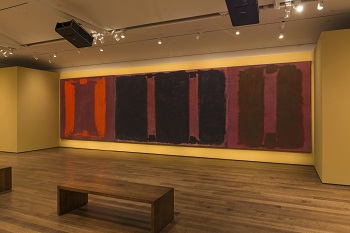
One thing the museum could change was its lighting. We perceive color when light strikes special cells in our eyes, called cones. By altering the color of the light shining on the paintings, conservators could change how the viewers’ eyes interpreted the paintings’ colors.
But first the scientists had to figure out what the paintings looked like when they were new.
Photographs from 1964 existed. However, like the paintings, they too had faded. So the conservators called on Rudolf Gschwind for help. An expert on film aging, he works at the University of Basel in Switzerland. Gschwind helped the Harvard team calculate the photos’ original colors. Conservators also studied the colors of a sixth, related mural that Rothko still owned.
From this information, the conservators created “target images” — depictions of what the murals must have looked like when they were new. Next they photographed each faded mural and used computer models to create “compensation images.” Khandekar describes these as “maps of the missing colors.” Each of these compensation images is made up of more than two million pixels, or tiny dots of color.
Five digital projectors now hang from the ceiling of the mural gallery. Each beams a compensation image onto one of the paintings. When visitors look at the murals, they see them as Rothko painted them. Even with the projectors on, though, lighting in the gallery is kept low to halt further fading.
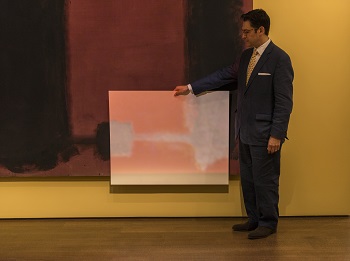
It took a team of five people — art historians and conservators — to “restore” the murals. These specialists worked with Gschwind and experts at the Massachusetts Institute of Technology.
“Some of us figured out why Rothko’s paints faded,” says Khandekar. “Others calculated how much color was missing. Still others wrote software that told the computers how to fix it.” Khandekar added his own expertise: organic chemistry and painting conservation. The paintings went on display in late November 2014 and will be shown through July 26, 2015.
By investigating how precious items age, experts like Young, Liefkes and Khandekar can assemble teams that use modern technology to fix the ravages of time. They work at a crossroads where art, science and history come together. And they don’t work alone. Finding answers usually requires tapping the skills and knowledge of researchers from many different fields.
We don’t usually see conservators when we visit museums. But we can see the fruits of their research and handiwork every time we admire an old and treasured artifact.
Power Words
(for more about Power Words, click here)
artifact An object made by people.
chemical bonds Attractive forces between atoms that are strong enough to make the linked elements function as a single unit. Some of the attractive forces are weak, some are very strong. All bonds appear to link atoms through a sharing of — or an attempt to share — electrons
chemistry The field of science that deals with the composition, structure and properties of substances and how they interact with one another. Chemists use this knowledge to study unfamiliar substances, to reproduce large quantities of useful substances or to design and create new and useful substances. (about compounds) The term is used to refer to the recipe of a compound, the way it’s produced or some of its properties.
civil war A war fought between two or more opposing groups that are citizens of the same country. In the U.S. Civil War, which took place from 1861 to 1865, southern “Confederate” states that had supported slavery fought unsuccessfully to break from the United States and form a new country.
computerized axial tomography (CAT or CT, for short). A special kind of x-ray scanning technology that produces cross-sectional views of the inside of a bone or body.
computer model A program that runs on a computer that creates a model, or simulation, of a real-world feature, phenomenon or event.
conservation The act of preserving or protecting something. The focus of this work can range from art objects to endangered species or other aspects of the natural environment.
conservator A person in charge of protecting and/or restoring valuable items.
corrode A process whereby metals react with gases or other materials in their environment and undergo a type of degradation. The rusting of iron, for instance, is one example of corrosion, driven by exposure to moisture.
curator Someone who manages a collection of items, for instance in a museum, library or art gallery. This person’s primary job is to design exhibits, organize and acquire collections and do research on the artifacts included in the collection.
digital (in electronics) A term for the type of technology based on semiconductors. (in computer science and engineering) An adjective indicating that something has been developed numerically on a computer or on some other electronic device, based on a binary system (where all numbers are displayed using a series of only zeros and ones).
glaze A material used to give a smooth, glossy coating to materials, especially porcelain. When pigments are included in this material, it can impart color to the surface as well.
graduate degree An advanced degree that universities offer, such as a Master’s degree or PhD. These are called graduate degrees because someone usually qualifies to start work on them only after already graduating from college (usually with a four-year degree).
laser A device that generates an intense beam of coherent light of a single color. Lasers are used in drilling and cutting, alignment and guidance, in data storage and in surgery.
mannequin A human form (often made of wood and/or plastic) that is used to display clothing in a store or other exhibit.
pixel Short for picture element. A tiny area of illumination on a computer screen, or a dot on a printed page, usually placed in an array to form a digital image. Photographs are made of thousands of pixels, each of different brightness and color, and each too small to be seen unless the image is magnified.
physics The scientific study of the nature and properties of matter and energy. Classical physics is an explanation of the nature and properties of matter and energy that relies on descriptions such as Newton’s laws of motion. It’s an alternative to quantum physics in explaining the motions and behavior of matter. A scientist who works in that field is known as a physicist.
pigment A material, like the natural colorings in skin, that alter the light reflected off of an object or transmitted through it. The overall color of a pigment typically depends on which wavelengths of visible light it absorbs and which ones it reflects. For example, a red pigment tends to reflect red wavelengths of light very well and typically absorbs other colors. Pigment also is the term for chemicals that manufacturers use to tint paint.
plasticizer Any of several chemicals added to certain synthetic materials to make them soft and/or pliable.
porcelain A hard, brittle material made by treating clay to a long heat treatment. The process, first perfected in Asia, came to be known as “china.” When treated before heating with a glaze, its surface can become impermeable, making it a good material for holding foods or liquids.
resin A sticky, sometimes aromatic substance, often secreted by plants. It may also be the viscous starting ingredient for some plastics that will harden when heated or treated with light.
scanner A machine that runs some sort of light (which includes anything from X-rays to infrared energy) over a person or object to get a succession of images. When a computer brings these images together, they can provide a motion picture of something or can offer a three-dimensional view through the target. Such systems are often used to see inside the human body or solid objects without breaching their surface.
silica gel A material that is crystalline when dry. It is used to absorb moisture from the environment. Manufacturers or museum conservators often include packets of this material to prevent moisture damage to valuable products (such as cameras or exhibited artifacts).
synthetic An adjective that describes something that did not arise naturally, but was instead created by people. Many have been developed to stand in for natural materials, such as synthetic rubber, synthetic diamond or a synthetic hormone. Some may even have a chemical makeup and structure identical to the original.
three-dimensional (3-D) printer A machine that takes instructions from a computer program on where to lay down successive layers of some raw material to create a three-dimensional object.
three-dimensional (3-D) printing The creation of a three-dimensional object with a machine that follows instructions from a computer program. The computer tells the printer where to lay down successive layers of some raw material, which can be plastic, metals, food or even living cells. 3-D printing is also called additive manufacturing.
ultraviolet A portion of the light spectrum that is close to violet but invisible to the human eye.
X-ray A type of radiation analogous to gamma rays, but of somewhat lower energy.
Word Find (click here to enlarge for printing)
